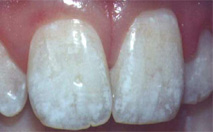In 1971, the National Academy of Sciences estimated that an adult’s daily average fluoride intake was about 1.0 – 1.5 mg/day in the early 1950s. This was considered“optimal” at the time. The chart below is a graphic example of how much we’re now getting. However, even the maximum values will not reflect true intakes for some subsets of the population. For example, athletes, diabetics, pregnant women, construction workers, and heavy tea drinkers can consume considerably more fluoride (up to 14 mgF/day). Case reports have shown that arthritis can be markedly alleviated by giving up tea.
 According to the World Health Organization, in combination with certain other factors (e.g., sub-optimal nutrition, kidney disease, etc.), a chronic fluoride intake of between 2.0 and 8.0 mg/day can produce the pre-clinical stage of skeletal fluorosis, a debilitating and/or crippling bone disease. The pre-clinical and early stages of skeletal fluorosis can be mistaken for arthritis.
According to the World Health Organization, in combination with certain other factors (e.g., sub-optimal nutrition, kidney disease, etc.), a chronic fluoride intake of between 2.0 and 8.0 mg/day can produce the pre-clinical stage of skeletal fluorosis, a debilitating and/or crippling bone disease. The pre-clinical and early stages of skeletal fluorosis can be mistaken for arthritis.
 Because of water fluoridation and other fluoride products, dental fluorosis is now pandemic in our children. It’s the first visible sign of fluoride poisoning. The structural integrity of enamel is compromised and small pits are left in teeth as it breaks away. Even with mild fluorosis, enamel is subject to increased erosion and attrition.
Because of water fluoridation and other fluoride products, dental fluorosis is now pandemic in our children. It’s the first visible sign of fluoride poisoning. The structural integrity of enamel is compromised and small pits are left in teeth as it breaks away. Even with mild fluorosis, enamel is subject to increased erosion and attrition.

